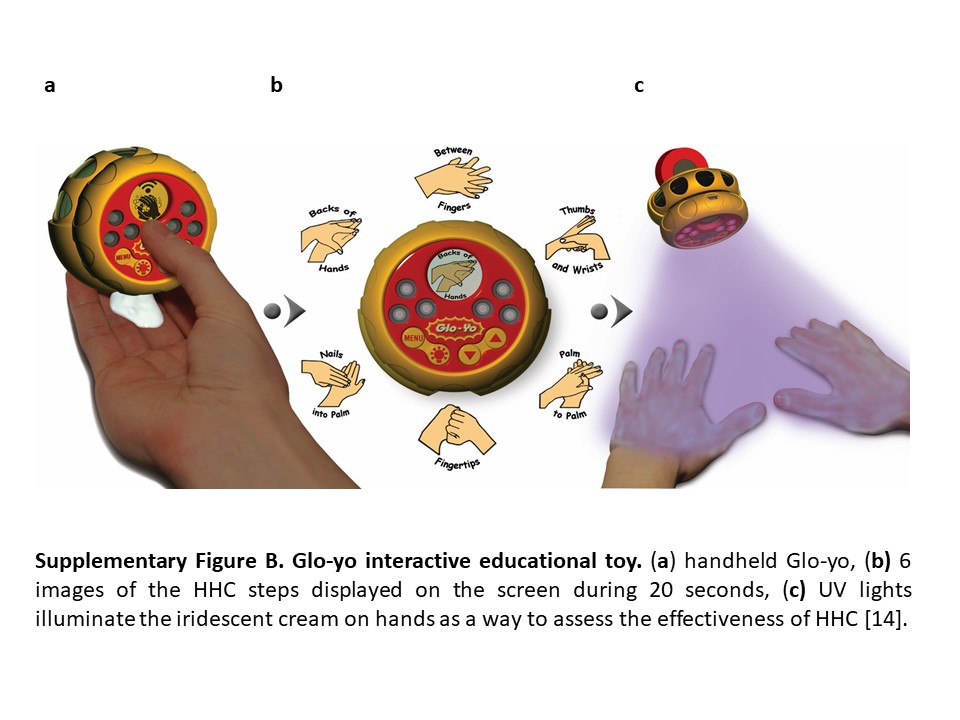
January 3, 2020, by Brigitte Nerlich
Spread the message, not the germs: A retrospective on a collaborative project
More or less exactly a decade ago, I was working on various science and society issues, including nanotechnology, antimicrobial resistance and infection control.
This brought me into contact with a variety of people at the University of Nottingham, including Kim Hardie, a molecular microbiologist, Joel Segal, a specialist in manufacturing engineering, Jacqueline Randle, then working in nursing and infection control, Caroline Windrum, then working as an administrator and fund raiser in educational research, and not to forget Helena Webb who was then working between Nottingham and King’s College, London.
On Kim’s suggestion we sat down together to come up with an educational and enjoyable ‘toy’ that might improve children’s hand hygiene practices – an important way to reduce the spread of drug resistant infections in hospital and at home. We also hoped that once the children got into hand washing they’d also educate/pester their parents or carers – they’d spread the message, not the germs.
Our work
We first presented our idea at an International Conference of Interactive Technologies and Games in 2010 under the title “Improving children’s hand hygiene compliance through play”. We also presented it at a university-wide ‘Bridging the gaps’ conference.
Our first article, led by Jacqueline Randle, appeared in 2013 and included the work of collaborators, such as James Metcalfe (engineering), Helena Webb (social sciences), JCA Luckett (medicine and health sciences) and Natalie Vaughan (infection prevention and control).
Kim continued to inspire and popularise this work, as you can see here – this is outreach at a large scale! She also attracted funding from the East Midlands Development Agency and from the University of Nottingham’s Hermes fund.
Why did we think this was so important?
Hand hygiene
Our first article set out what we wanted to achieve and why.
Hand hygiene compliance is the single most effective way to reduce healthcare-associated infections. Children are notoriously vulnerable to infection as well as acting as conduits to transmission. Based on these observations, we formulated the hypothesis that behavioural change which improved children’s hand hygiene compliance would decrease the spread of infectious diseases.
Our aim was to create an educational intervention to induce long-term behavioural change culminating in increased hand hygiene compliance of children, and thus a decrease in the rate of infections.
Focus groups conducted during interactive teaching sessions identified what children felt would help them to increase their hand hygiene compliance. This informed the design of an educational device that was subsequently trialled to measure its effectiveness in increasing hand hygiene compliance. Initial developmental stages were conducted in two schools in the East Midlands with study participants aged 5–8 years; the device was subsequently used in a healthcare setting to assess deployment flexibility.
We found that children enjoyed interactive learning, developed knowledge about cross-transmission of infections, and became motivated to encourage others to improve hand hygiene compliance. Microbiological swabbing verified the presence of pathogens on children’s hands and environmental surfaces that could serve as reservoirs of infection, and questionnaires indicated an increase in handwashing following the intervention.
What was the toy we used?
The Glo-Yo
The toy we developed was the Glo-yo, an interactive device intended to encourage children to wash their hands. The product design was led by James Metcalfe, then an engineering student and by Helena Webb, then a PhD student at the Institute for Science and Society. Importantly, it was designed with the help and input of children!
This is a yo-yo engineered to have various functions. Crucially, it displays on a computer screen the most important steps in hand-washing, contains a special lotion and has a little torch with ultra-violet light that children can shine on their hands. They can use this to check that they have removed all the special lotion from their hands after washing.
Click here to see all the impressive features of the Glo-Yo as detailed by James Metcalfe himself!!
We are still looking for a manufacturer though…., so that we can roll out larger trials.
New article
The latest and possibly last article resulting from our work, and that of Kim’s PhD students and post-docs, appeared in the Journal of Infection Prevention just before Christmas 2019. The work for this article was led by Dina Lary (biomolecular and Kim, and includes contributions by Aaron Calvert (biomolecular sciences) and the team.
Infection control is an ever-present issue in hospitals but also in homes. We hope that this work can contribute to spreading the word about the importance of hand-hygiene, about engaging children playfully in learning about this issue and thus reducing the spread of infections, including drug resistant infections.
No comments yet, fill out a comment to be the first


Leave a Reply